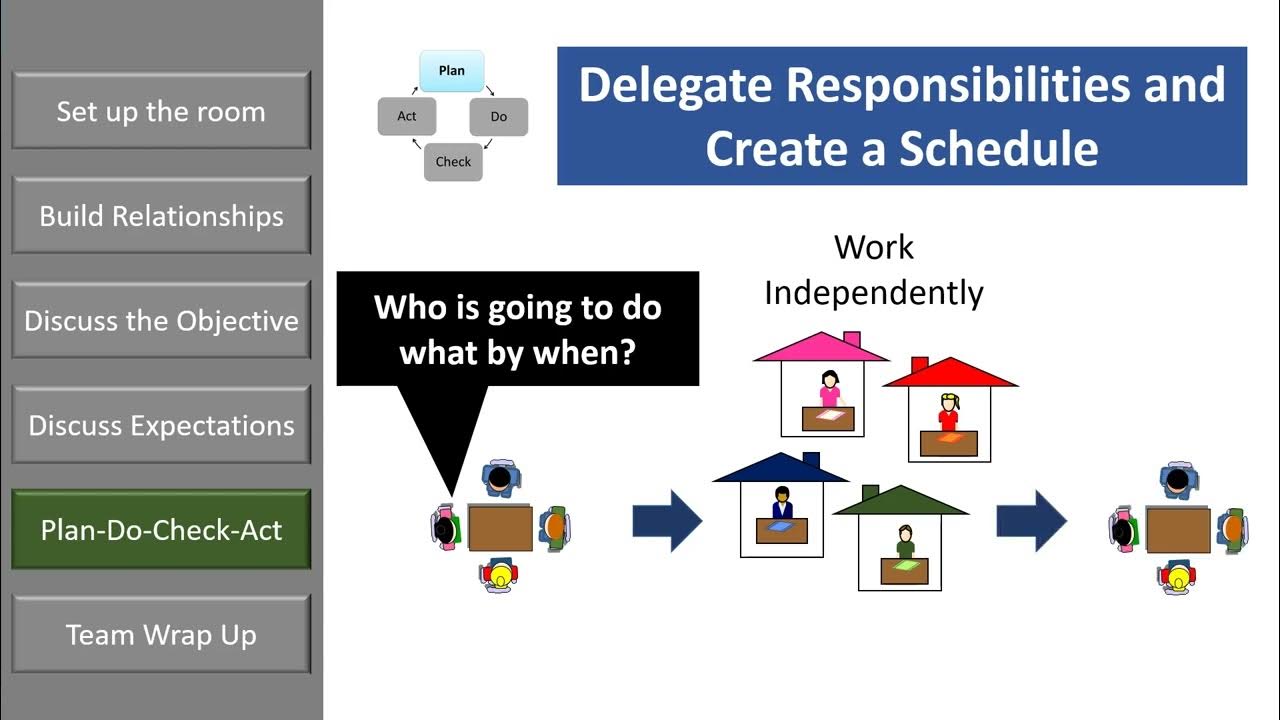Collaborative Teamwork
Summary
TLDRJames Peterson introduces the importance of communication in teamwork and collaboration across various professions. Highlighting the concept of interprofessionalism, especially in healthcare, he emphasizes the value of diverse expertise for enhanced project outcomes. The video explores leadership behaviors, advocating for a collaborative style that balances warmth towards people with a tough stance on problems. Peterson concludes by urging an 'I don't know' attitude in team meetings to foster learning and mutual understanding, essential for effective teamwork.
Takeaways
- 😀 Teamwork is essential across all professions and industries, as it enhances the quality of work through collaboration.
- 🔄 Interprofessionalism, especially in healthcare, emphasizes collaboration between professionals from different disciplines to improve patient outcomes.
- 🏗️ Complex projects, such as building a bridge, require extensive collaboration and address various issues including design, construction, safety, environment, budget, and traffic.
- 🤝 The advantage of teams is the diversity of thought, with different individuals focusing on and addressing different critical issues.
- 📚 The book 'Leadership through People Skills' introduces the concept of 360-degree leadership, applicable to various roles within a team.
- 🌟 Leadership is distinguished from management, focusing on being proactive and objective-focused, rather than just holding a managerial position.
- 📏 The dimensional model of leadership behavior outlines two key dimensions: people skills (warmth vs. hostility) and proactiveness (dominance vs. submission).
- 👑 Q4 leadership, characterized by a collaborative style, is the most effective for achieving the best results, combining dominance and warmth.
- 🗣️ Communication in team-based collaboration is crucial, with Q4 leadership promoting two-way communication that discusses and resolves disagreements.
- 🔄 Recognize that individuals may switch between leadership styles depending on the team and situation, understanding the importance of collaborative leadership.
- 💡 The core of collaborative leadership is being warm with people and tough with problems, fostering an environment of mutual respect and open discussion for optimal outcomes.
Q & A
What is the main topic of the video script?
-The main topic of the video script is an introduction to teamwork, specifically focusing on communication for team-based collaboration.
Why is teamwork important across different professions?
-Teamwork is important because it is often a requirement of the job, and when embraced properly, it can dramatically enhance the quality of work by leveraging diverse skills, expertise, and ideas.
What does the term 'interprofessionalism' refer to, particularly in healthcare?
-Interprofessionalism refers to collaboration between professionals from different disciplines or areas of expertise, with the goal of improving health outcomes for patients and providing seamless care.
Can you provide an example of a complex team project mentioned in the script?
-An example of a complex team project mentioned is building a bridge over a small creek, which involves collaboration between engineers, construction workers, government employees, and others.
What are some of the critical issues that need to be addressed in the bridge-building project?
-Critical issues include safety, environmental concerns, budget and time constraints, neighborhood considerations, traffic management, and providing facilities for workers.
What is the difference between management and leadership as described in the script?
-Management is a position in a company with authority to make decisions, while leadership is about being objective-focused, proactive, and taking initiative to solve problems or improve situations.
What are the two dimensions of the dimensional model of leadership behavior?
-The two dimensions are the horizontal dimension of people skills (hostility to warmth) and the vertical dimension of proactiveness (submission to dominance).
What are the four leadership styles described by the model?
-The four leadership styles are Q1 - Autocratic and Hostile, Q2 - Unassertive and Hostile, Q3 - Easy Going and Hostile, and Q4 - Collaborative and Warm.
Why is Q4 leadership considered the most effective style for team collaboration?
-Q4 leadership is effective because it combines a positive view of people (warmth) with a proactive approach to problem-solving (dominance), fostering an environment of open communication and mutual respect.
What is the core idea behind collaborative leadership?
-The core idea behind collaborative leadership is to be warm with people, valuing their contributions, and tough with problems, caring about the project's outcome and seeking the best solutions.
How should one approach team meetings to foster collaborative teamwork?
-One should approach team meetings with an 'I don't know' attitude, being open to learning from others, sharing valuable information, and working together to understand and address project issues.
Outlines

This section is available to paid users only. Please upgrade to access this part.
Upgrade NowMindmap

This section is available to paid users only. Please upgrade to access this part.
Upgrade NowKeywords

This section is available to paid users only. Please upgrade to access this part.
Upgrade NowHighlights

This section is available to paid users only. Please upgrade to access this part.
Upgrade NowTranscripts

This section is available to paid users only. Please upgrade to access this part.
Upgrade NowBrowse More Related Video

Developing Good Habits for Working in Teams (Part 2)

Developing Good Habits for Working in Teams (Part 1)

IPE Core Competency Domain 2: Roles/Responsibilities

Collaborating at work: The collaboration skills you need to succeed

Organize, Collaboration & Analytic and Customer Use Cases

Lessons from the Field: Promising Interprofessional Collaboration
5.0 / 5 (0 votes)